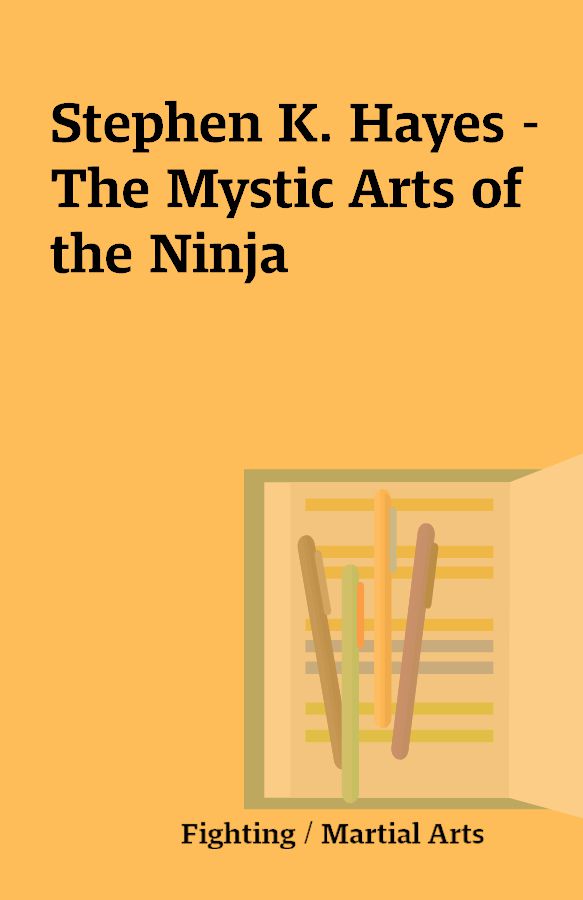Stephen K. Hayes – The Mystic Arts of the Ninja
Stephen K. Hayes – The Mystic Arts of the Ninja.pdf
[1 eBook – PDF]
Description
Stephen K. Hayes – The Mystic Arts of the Ninja 160 pagesPublished April 1, 1985Language: EnglishNinja . . . that single word conjures up images of mystery and power. The ability to move swiftly and silently, to mesmerize one’s victim, to strike infallibly, and then to disappear into the night–this is the legend of the ninja. These nearly sorcerous aspects of the ninja, as well as the exotic weapons they use, are the focus of The Mystic Arts of the Ninja. Its author, Shidoshi Stephen K. Hayes, is the sole American to be granted teaching credentials by the 34th grandmaster of the Togokure School of Ninjutsu in Japan. Going beyond the basic conditioning and training techniques of his best-selling Ninjutsu: The Art of the Invisible Warrior, Hayes explains the most sought after secrets of his ninja training: Hypnotism: Saiminjutsu, the ninja’s hypnotic powers are described and explained. Sample exercises are provided to help develop your hypnotic powers. Invisibility: Stealth walking and camouflage are discussed. Hayes provides examples of how to move silently across various kinds of terrain and how to blend into your surroundings to become invisible. Weaponry: The Hanbo cane, the sword, and the infamous shuriken throwing stars are ninja trademarks. Hayes fully describes their use in grappling as well as in attacking. More than 400 black-and-white photos are used to illustrate the secrets and techniques that have been used by the ninja to surprise and outwit their foes over the past 800 years. The authenticity of Shidoshi Hayes’s instruction is perhaps the most important aspect of this book: no other book represents the true ninja tradition.Community Reviews:This book had a little of everything. How to walk quietly, how to properly hold a sword, or a rope. It demonstrates the basics of the “Hanbo” (half-staff) and the ninja-to (ninja sword). It also delves a little into the meditations, and the arts of the mind.It’s a kind of salad bar… it has a little bit of everything for everyone. This book is an early work by the United States’ first shidoshi (licensed instructor) in the nine martial arts schools of the Bujinkan dojo. It contains a fascinating history of the Japanese secret warriors who history would eventually call ninja. Then the book presents various aspects of ninjutsu, including some things not often taught today, like stealthy movement and escape. The chapter on ninja tools includes a very useful chart of the various kamae (postures) used when holding a sword. My only negative comment is that a lot of pages are spent showing frame by frame pictures of taijutsu techniques, and nowadays video is a much more effective medium for teaching those techniques. It’s almost impossible to learn these techniques from a static photograph. Overall, this book is an interesting and informative read for people interested in the history and more esoteric aspects of ninjutsu. It is one of many good books by Stephen K. Hayes. The Mystic Arts of the Ninja begins with a discussion of the history of ninjutsu and some of its historical figures such as: Hattori Hanzo, Fujibayashi Nagato, and Kato Danjo. This historical view of ninjutsu is then compared with the limited conventional view of the day revolving around moonlit nights with black masked assassins murdering their enemies.Following this discussion of history, Stephen Hayes then explains the Fu No Kata, and how fighting skills for self-protection are much different than the martial arts often taught in sport focused schools. Japanese ninjutsu evolved from the need for pragmatic self-protection under difficult odds in a time of continuous civil warfare.The Mystic Arts of the Ninja then continues with a discussion of ninja aruhi ~ stealth and ningu ~ ninja tools to include the han-bo and ninja sword. Both of these sections contain several photos (as does the whole book) helping the reader learn the techniques described.In-ton the art of concealment and camouflage is discussed next. This chapter includes a discussion on gontonpo ~ the five element concealing and escaping methods. Gontonpo looks at general combat and escape strategies as represented by the five elements: Wood, Fire, Earth, metal, and Water.Stephen Hayes continues with a discussion of the shuriken. Although often thought of as a “ninja weapon” many other Ryu included shurikenjutsu as part of their training. Here however we see the way the shuriken is employed within the art of ninjutsu.The book concludes with a brief discussion of saiminjutsu ~ the ninja’s power of directing the mind.To see my other uploads, search adishonerv69
You must be logged in to post a review.






Reviews
There are no reviews yet.